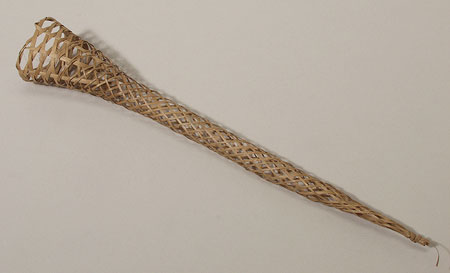Accession Number:
1931.59.5
Country:
Sudan
Region:
[Southern Sudan] Uele District
Cultural Group:
Zande
Date Made:
By 1930
Materials:
Cane Plant
Process:
Basketry
Dimensions:
L = 422 mm, L opening = 72, W opening = 52 mm, W body strips = 2 mm, W strips around mouth = 4 mm [RTS 26/5/2004].
Weight:
6.4 g
Local Name:
ngbatu?
Other Owners:
Probably collected by Evans-Pritchard himself during his fieldwork amongst the Zande, which took place during 1927, part of 1928 and 1929 and for several months during 1930 [CM; RTS 6/7/2004].
Field Collector:
Edward Evan Evans-Pritchard?
PRM Source:
Edward Evan Evans-Pritchard
Acquired:
Donated 1931
Collected Date:
1927 - 1930
Description:
Rat trap consisting of a flexible, tubular, elongated body with oval mouth that gradually tapers to a point at the other end.
This has been made by taking 8 long strips of flat cane, 4 mm wide, and weaving them loosely together into an open bias (e.g.: diagonal) checkweave, leaving diamond-shaped openings down the sides.
The loose ends of each strip has been bent over and woven into the pattern, forming a third vertical or slightly oblique element that also serves to strengthen the mouth of the trap.
Where these loose ends finish, about 40 mm or four rows below the mouth, each of the diagonal cane strips has been split into two thinner, 2 mm wide sections which are then woven as separate strands.
These get closer together towards the base of the trap, where they are gathered into a point and bound with another cane strip.
The trap is complete, but the surface of the cane strips appears to be flaking off in some areas.
This is currently a pale yellowish brown colour (Pantone 7509C).
It measures 422 mm in length, while the mouth is 72 by 52 mm wide, with a weight of 6.4 grams.
Probably collected by Evans-Pritchard himself during his fieldwork amongst the Zande, which took place during 1927, part of 1928 and 1929 and for several months during 1930.
The Zande appear to use two different types of rat trap; a rigid variety with thorns set inside the mouth (see also 1931.59.1-3), and a flexible trap without thorns, as here (see 1931.59.4). Evans-Pritchard was probably referring to these two types when he commented that "the funnel-shaped baskets used to trap mice ( ngbatu ) are of two kinds, the one Mbomu and the other Miangba" (E.E. Evans-Pritchard, 1963 "A Further Contribution to the Study of Zande Culture", Africa 33.3, p. 191), although it is not clear which of these types is represented here. The Lotuko also use a similar style of rigid trap (see 1946.3.16), while Schweinfurth describes Bongo boys using similar basketry tubes to catch rats and field mice, as a source of food, or to use as bait in catching cats (G. Schweinfurth, 1873, The Heart of Africa Vol. 1, pp 273-4).
Rachael Sparks 27/8/2005.
Probably collected by Evans-Pritchard himself during his fieldwork amongst the Zande, which took place during 1927, part of 1928 and 1929 and for several months during 1930.
The Zande appear to use two different types of rat trap; a rigid variety with thorns set inside the mouth (see also 1931.59.1-3), and a flexible trap without thorns, as here (see 1931.59.4). Evans-Pritchard was probably referring to these two types when he commented that "the funnel-shaped baskets used to trap mice ( ngbatu ) are of two kinds, the one Mbomu and the other Miangba" (E.E. Evans-Pritchard, 1963 "A Further Contribution to the Study of Zande Culture", Africa 33.3, p. 191), although it is not clear which of these types is represented here. The Lotuko also use a similar style of rigid trap (see 1946.3.16), while Schweinfurth describes Bongo boys using similar basketry tubes to catch rats and field mice, as a source of food, or to use as bait in catching cats (G. Schweinfurth, 1873, The Heart of Africa Vol. 1, pp 273-4).
Rachael Sparks 27/8/2005.
Primary Documentation:
Accession Book Entry
[IX, p.
8] 1931 [insert, in pencil] 59 [end insert] -
E.
E.
EVANS-PRITCHARD
, Esq.
[in pencil] 4-5 - [1 of] 2 Very similar rat-traps, but flexible & with the returning ends of the cane strips forming a barrier to egress.
The framework gives & expands while a rat is pushing its way in, but contracts under tension if it tries to back out of the tube, & so grips the beast tightly.
Same data [AZANDE, WELLE district, E.
SUDAN].
Old Pitt Rivers Museum label - Flexible tubular rat-trap, which contracts under tension. AZANDE, WELLE dist., E. SUDAN. Pres. by E. Evans Prtichard, 1931 [rectangular metal edged tag, tied to object; RTS 26/5/2004].
Old Pitt Rivers Museum label - Flexible tubular rat-trap, which contracts under tension. AZANDE, WELLE dist., E. SUDAN. Pres. by E. Evans Prtichard, 1931 [rectangular metal edged tag, tied to object; RTS 26/5/2004].




